child seat CADILLAC XLR 2008 1.G Owners Manual
[x] Cancel search | Manufacturer: CADILLAC, Model Year: 2008, Model line: XLR, Model: CADILLAC XLR 2008 1.GPages: 470, PDF Size: 8.39 MB
Page 1 of 470
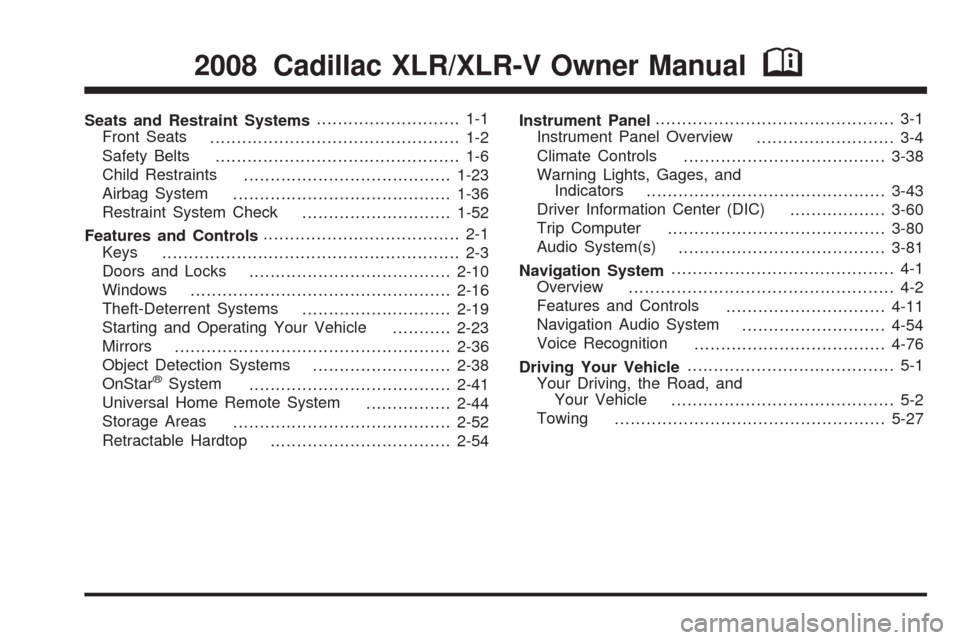
Seats and Restraint Systems........................... 1-1
Front Seats
............................................... 1-2
Safety Belts
.............................................. 1-6
Child Restraints
.......................................1-23
Airbag System
.........................................1-36
Restraint System Check
............................1-52
Features and Controls..................................... 2-1
Keys
........................................................ 2-3
Doors and Locks
......................................2-10
Windows
.................................................2-16
Theft-Deterrent Systems
............................2-19
Starting and Operating Your Vehicle
...........2-23
Mirrors
....................................................2-36
Object Detection Systems
..........................2-38
OnStar
®System
......................................2-41
Universal Home Remote System
................2-44
Storage Areas
.........................................2-52
Retractable Hardtop
..................................2-54Instrument Panel............................................. 3-1
Instrument Panel Overview
.......................... 3-4
Climate Controls
......................................3-38
Warning Lights, Gages, and
Indicators
.............................................3-43
Driver Information Center (DIC)
..................3-60
Trip Computer
.........................................3-80
Audio System(s)
.......................................3-81
Navigation System.......................................... 4-1
Overview
.................................................. 4-2
Features and Controls
..............................4-11
Navigation Audio System
...........................4-54
Voice Recognition
....................................4-76
Driving Your Vehicle....................................... 5-1
Your Driving, the Road, and
Your Vehicle
.......................................... 5-2
Towing
...................................................5-27
2008 Cadillac XLR/XLR-V Owner ManualM
Page 7 of 470
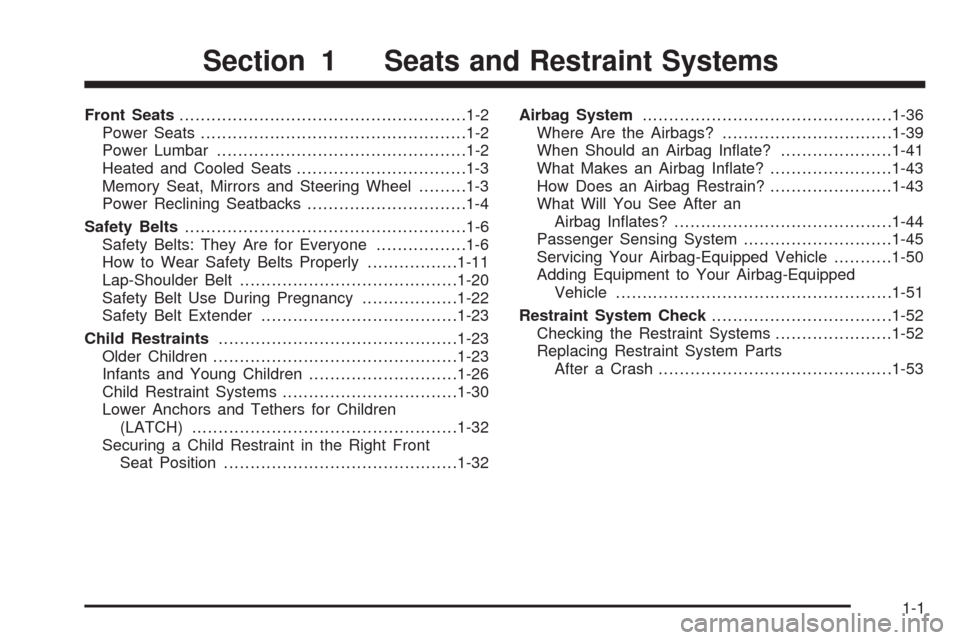
Front Seats......................................................1-2
Power Seats..................................................1-2
Power Lumbar...............................................1-2
Heated and Cooled Seats................................1-3
Memory Seat, Mirrors and Steering Wheel.........1-3
Power Reclining Seatbacks..............................1-4
Safety Belts.....................................................1-6
Safety Belts: They Are for Everyone.................1-6
How to Wear Safety Belts Properly.................1-11
Lap-Shoulder Belt.........................................1-20
Safety Belt Use During Pregnancy..................1-22
Safety Belt Extender.....................................1-23
Child Restraints.............................................1-23
Older Children..............................................1-23
Infants and Young Children............................1-26
Child Restraint Systems.................................1-30
Lower Anchors and Tethers for Children
(LATCH)..................................................1-32
Securing a Child Restraint in the Right Front
Seat Position............................................1-32Airbag System...............................................1-36
Where Are the Airbags?................................1-39
When Should an Airbag In�ate?.....................1-41
What Makes an Airbag In�ate?.......................1-43
How Does an Airbag Restrain?.......................1-43
What Will You See After an
Airbag In�ates?.........................................1-44
Passenger Sensing System............................1-45
Servicing Your Airbag-Equipped Vehicle...........1-50
Adding Equipment to Your Airbag-Equipped
Vehicle....................................................1-51
Restraint System Check..................................1-52
Checking the Restraint Systems......................1-52
Replacing Restraint System Parts
After a Crash............................................1-53
Section 1 Seats and Restraint Systems
1-1
Page 26 of 470

Lap-Shoulder Belt
All seating positions in your vehicle have a
lap-shoulder belt.
Here is how to wear a lap-shoulder belt properly.
1. Adjust the seat, if the seat is adjustable, so you can
sit up straight. To see how, see “Seats” in the Index.
2. Pick up the latch plate and pull the belt across you.
Do not let it get twisted.
The lap-shoulder belt may lock if you pull the belt
across you very quickly. If this happens, let the belt
go back slightly to unlock it. Then pull the belt
across you more slowly.
If you ever pull the shoulder portion of a passenger
belt out all the way, you may engage the child
restraint locking feature. If this happens, just let the
belt go back all the way and start again.
Engaging the child restraint locking feature may
affect the passenger sensing system. SeePassenger
Sensing System on page 1-45.3. Push the latch plate into the buckle until it clicks.
Pull up on the latch plate to make sure it is secure.
If the belt is not long enough, seeSafety Belt
Extender on page 1-23.
Make sure the release button on the buckle is
positioned so you would be able to unbuckle the
safety belt quickly if necessary.
1-20
Page 29 of 470

Safety Belt Extender
If the vehicle’s safety belt will fasten around you,
you should use it.
But if a safety belt is not long enough, your
dealer/retailer will order you an extender. When you
go in to order it, take the heaviest coat you will wear,
so the extender will be long enough for you. To help
avoid personal injury, do not let someone else
use it, and use it only for the seat it is made to �t.
The extender has been designed for adults. Never use
it for securing child seats. To wear it, attach it to the
regular safety belt. For more information, see the
instruction sheet that comes with the extender.
Child Restraints
Older Children
Older children who have outgrown booster seats should
wear the vehicle’s safety belts.
1-23
Page 30 of 470
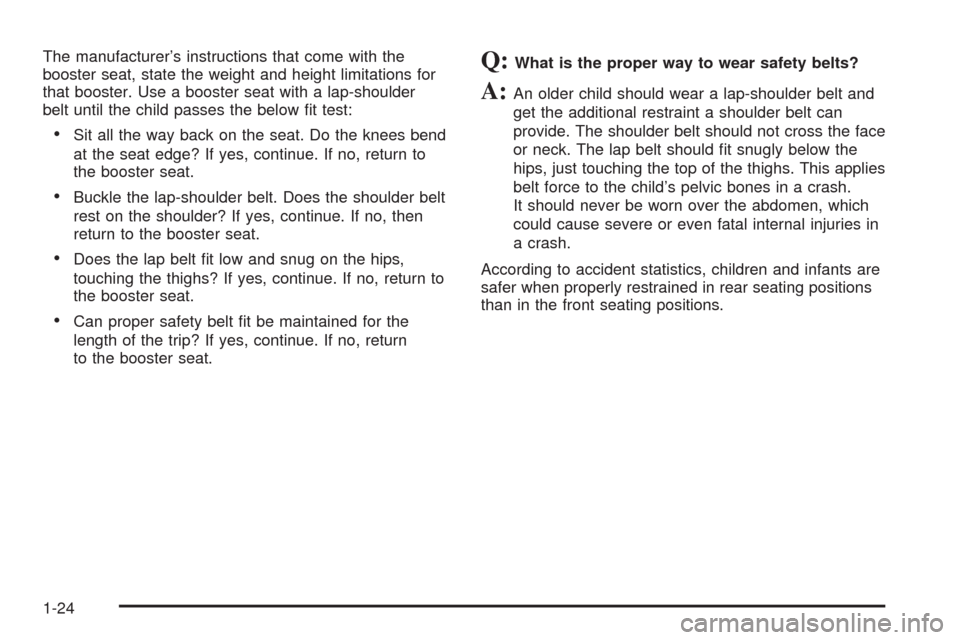
The manufacturer’s instructions that come with the
booster seat, state the weight and height limitations for
that booster. Use a booster seat with a lap-shoulder
belt until the child passes the below �t test:
Sit all the way back on the seat. Do the knees bend
at the seat edge? If yes, continue. If no, return to
the booster seat.
Buckle the lap-shoulder belt. Does the shoulder belt
rest on the shoulder? If yes, continue. If no, then
return to the booster seat.
Does the lap belt �t low and snug on the hips,
touching the thighs? If yes, continue. If no, return to
the booster seat.
Can proper safety belt �t be maintained for the
length of the trip? If yes, continue. If no, return
to the booster seat.
Q:What is the proper way to wear safety belts?
A:An older child should wear a lap-shoulder belt and
get the additional restraint a shoulder belt can
provide. The shoulder belt should not cross the face
or neck. The lap belt should �t snugly below the
hips, just touching the top of the thighs. This applies
belt force to the child’s pelvic bones in a crash.
It should never be worn over the abdomen, which
could cause severe or even fatal internal injuries in
a crash.
According to accident statistics, children and infants are
safer when properly restrained in rear seating positions
than in the front seating positions.
1-24
Page 32 of 470

{CAUTION:
Never do this.
Here a child is sitting in a seat that has a
lap-shoulder belt, but the shoulder part is
behind the child. In a crash, the child would
not be restrained by the shoulder belt. The
child might slide under the lap belt. The belt
force would then be applied right on the
abdomen. That could cause serious or fatal
injuries. The child could also move too far
forward increasing the chance of head and
neck injury. The shoulder belt should go over
the shoulder and across the chest.
Infants and Young Children
Everyone in a vehicle needs protection! This includes
infants and all other children. Neither the distance
traveled nor the age and size of the traveler changes
the need, for everyone, to use safety restraints. In fact,
the law in every state in the United States and in
every Canadian province says children up to some age
must be restrained while in a vehicle.
1-26
Page 35 of 470

{CAUTION:
Newborn infants need complete support,
including support for the head and neck.
This is necessary because a newborn infant’s
neck is weak and its head weighs so much
compared with the rest of its body. In a crash,
an infant in a rear-facing seat settles into
the restraint, so the crash forces can be
distributed across the strongest part of an
infant’s body, the back and shoulders. Infants
should always be secured in appropriate infant
restraints.
{CAUTION:
The body structure of a young child is quite
unlike that of an adult or older child, for whom
the safety belts are designed. A young child’s
hip bones are still so small that the vehicle’s
regular safety belt may not remain low on the
hip bones, as it should. Instead, it may settle
up around the child’s abdomen. In a crash,
the belt would apply force on a body area
that is unprotected by any bony structure.
This alone could cause serious or fatal
injuries. Young children should always be
secured in appropriate child restraints.
1-29
Page 36 of 470

Child Restraint Systems
A rear-facing infant
seat (A) provides restraint
with the seating surface
against the back of
the infant.
The harness system holds the infant in place and, in a
crash, acts to keep the infant positioned in the restraint.
A forward-facing child
seat (B) provides restraint
for the child’s body
with the harness.A booster seat (C-D) is a child restraint designed to
improve the �t of the vehicle’s safety belt system.
A booster seat can also help a child to see out the
window.
1-30
Page 37 of 470
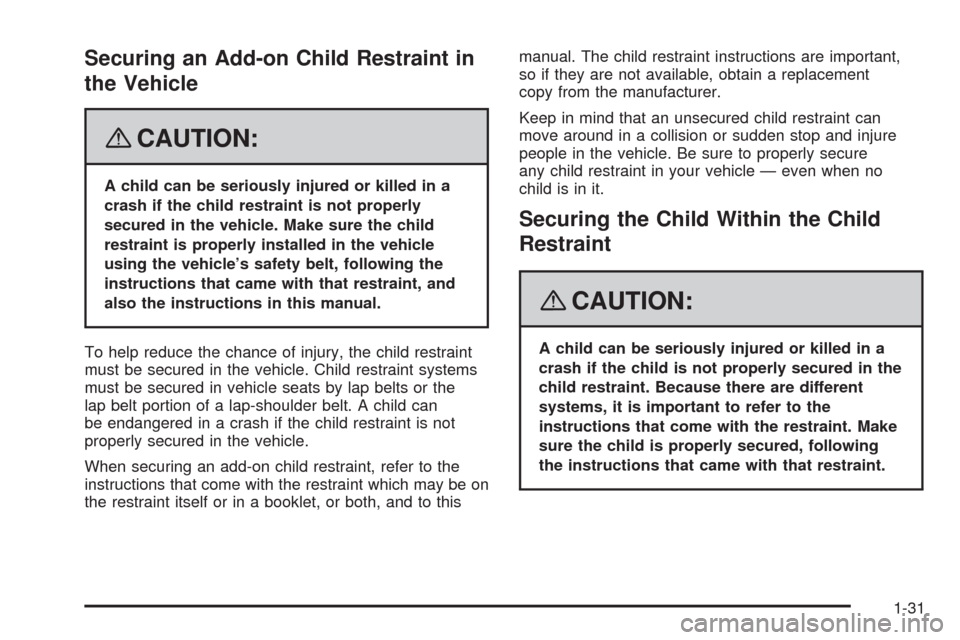
Securing an Add-on Child Restraint in
the Vehicle
{CAUTION:
A child can be seriously injured or killed in a
crash if the child restraint is not properly
secured in the vehicle. Make sure the child
restraint is properly installed in the vehicle
using the vehicle’s safety belt, following the
instructions that came with that restraint, and
also the instructions in this manual.
To help reduce the chance of injury, the child restraint
must be secured in the vehicle. Child restraint systems
must be secured in vehicle seats by lap belts or the
lap belt portion of a lap-shoulder belt. A child can
be endangered in a crash if the child restraint is not
properly secured in the vehicle.
When securing an add-on child restraint, refer to the
instructions that come with the restraint which may be on
the restraint itself or in a booklet, or both, and to thismanual. The child restraint instructions are important,
so if they are not available, obtain a replacement
copy from the manufacturer.
Keep in mind that an unsecured child restraint can
move around in a collision or sudden stop and injure
people in the vehicle. Be sure to properly secure
any child restraint in your vehicle — even when no
child is in it.
Securing the Child Within the Child
Restraint
{CAUTION:
A child can be seriously injured or killed in a
crash if the child is not properly secured in the
child restraint. Because there are different
systems, it is important to refer to the
instructions that come with the restraint. Make
sure the child is properly secured, following
the instructions that came with that restraint.
1-31
Page 38 of 470
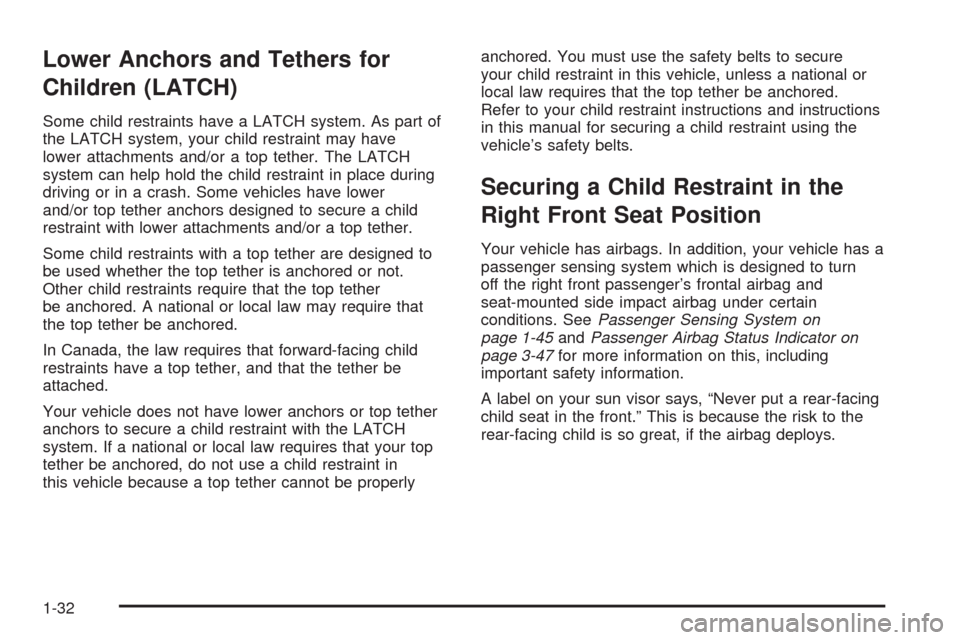
Lower Anchors and Tethers for
Children (LATCH)
Some child restraints have a LATCH system. As part of
the LATCH system, your child restraint may have
lower attachments and/or a top tether. The LATCH
system can help hold the child restraint in place during
driving or in a crash. Some vehicles have lower
and/or top tether anchors designed to secure a child
restraint with lower attachments and/or a top tether.
Some child restraints with a top tether are designed to
be used whether the top tether is anchored or not.
Other child restraints require that the top tether
be anchored. A national or local law may require that
the top tether be anchored.
In Canada, the law requires that forward-facing child
restraints have a top tether, and that the tether be
attached.
Your vehicle does not have lower anchors or top tether
anchors to secure a child restraint with the LATCH
system. If a national or local law requires that your top
tether be anchored, do not use a child restraint in
this vehicle because a top tether cannot be properlyanchored. You must use the safety belts to secure
your child restraint in this vehicle, unless a national or
local law requires that the top tether be anchored.
Refer to your child restraint instructions and instructions
in this manual for securing a child restraint using the
vehicle’s safety belts.
Securing a Child Restraint in the
Right Front Seat Position
Your vehicle has airbags. In addition, your vehicle has a
passenger sensing system which is designed to turn
off the right front passenger’s frontal airbag and
seat-mounted side impact airbag under certain
conditions. SeePassenger Sensing System on
page 1-45andPassenger Airbag Status Indicator on
page 3-47for more information on this, including
important safety information.
A label on your sun visor says, “Never put a rear-facing
child seat in the front.” This is because the risk to the
rear-facing child is so great, if the airbag deploys.
1-32